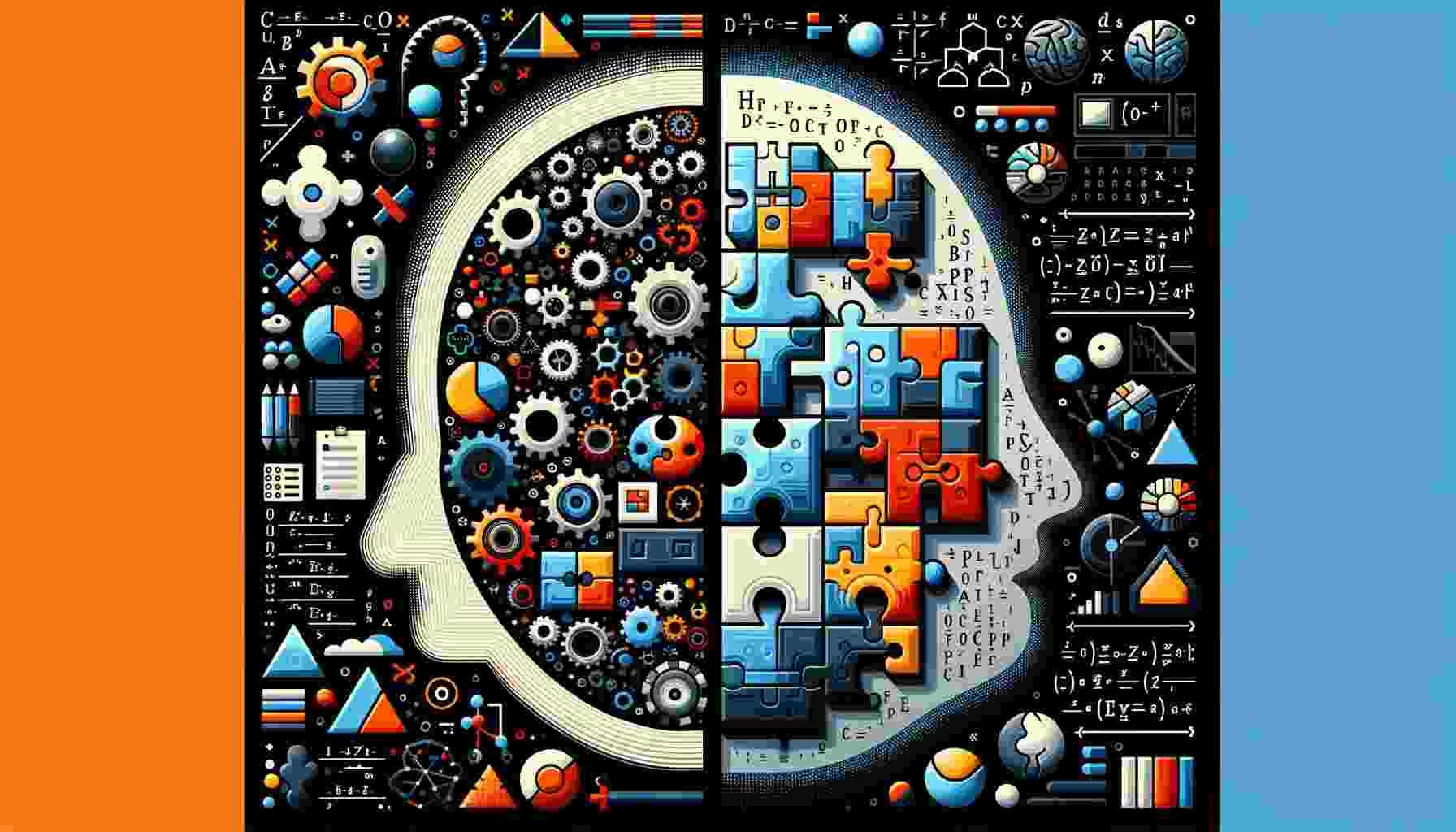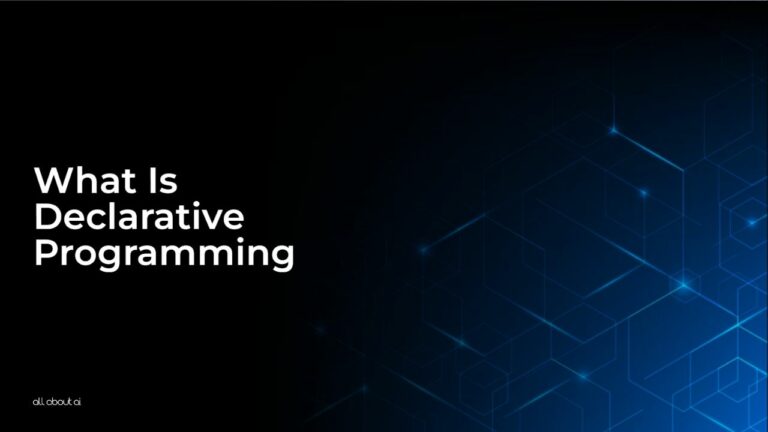Declarative programming is a paradigm in computer programming that expresses the logic of a computation without detailing its control flow. It emphasizes the declaration of what the program should accomplish rather than specifying the exact steps to achieve it. This high-level approach allows programmers to express their intentions more clearly and concisely.
In this article, we will discuss “What is declarative programming?” in detail, along with its characteristics, components, real-life examples, and everything in between. So what are you waiting for? Keep reading this article written by AI Researcher at All About AI.
What is Declarative Programming?: The Lazy Programmer’s Guide
Imagine you have a magic book that can do your homework for you. You just have to tell the book what you want to be done, like “I want my math homework finished,” without telling it how to do each math problem step by step. Declarative programming is like using this magic book in computer world. It’s a way of telling a computer what you want it to do, like making a drawing or counting numbers, but not how to do every little step. It’s like saying, “Computer, I want a picture of a dog,” instead of teaching it how to draw a dog from scratch.
What Is Declarative Programming?- An Overview:
Now that you understand the basic concept of “What is Declarative Programming?”, let’s get started taking an overview of it.

Focus on ‘What’ Not ‘How’:
In declarative programming, the programmer specifies what the desired outcome is, but not how to achieve it. This contrasts with imperative programming, where the focus is on writing the exact sequence of commands to perform a task.
Abstraction of Control Flow:
The control flow in declarative programming is often managed by the underlying system, allowing developers to focus on the business logic or high-level goals of the program.
Ease of Understanding:
Programs written declaratively are usually easier to understand since they describe intent rather than the specific steps to achieve an outcome.
Use in Various Domains:
This style of programming is particularly prevalent in domains like web development (HTML, CSS), database queries (SQL), and configuration management systems.
Flexibility:
Declarative programming often results in more flexible and adaptable code, as high-level declarations are less tightly bound to specific execution scenarios.
Contrast with Imperative Programming:
While imperative programming involves explicitly detailing the steps to achieve a goal, declarative programming focuses on the goal itself.
Step-by-Step Instructions:
In imperative programming, a programmer provides detailed instructions on how the program should operate.
Control Flow Management:
Imperative programming requires the programmer to manage the flow of the program, often through constructs like loops and conditionals.
State Changes:
Imperative programs typically involve more explicit state management, where the state can change over time as a result of specific instructions.
Key Concepts of Declarative Programming:
Declarative programming is characterized by its abstraction and focus on the ‘what’ rather than the ‘how’.

High-Level Abstraction:
Programs are written at a more abstract level, closer to human language and further from machine code.
Less Concern with Control Flow:
The details of control flow are often abstracted away, managed by the underlying programming environment or language runtime.
Focus on What not How:
The emphasis is on describing the desired outcome. For example, in a SQL query, you describe what data you want, not how to search for it.
Modularity:
This approach often leads to more modular code, as individual components describe their desired behavior or state independently.
Ease of Maintenance:
Declarative code can be easier to understand and maintain, as changes in one part of the system are less likely to have unexpected effects in others.
Common Use Cases in Databases and Configuration Management:
Now that we have understood “What is Declarative Programming?” let’s find out its common use cases in dababases and configuration management.
Database Queries:
SQL is a classic example of declarative programming, where queries express the data requirements, not the retrieval process.
Configuration Management:
Tools like Ansible or Terraform allow users to declare the desired state of a system, rather than the steps to achieve it.
Simplifies Complex Tasks:
Declarative approaches can simplify the management of complex systems, as the system handles the details of executing high-level specifications.
Readability:
Declarative code in these domains tends to be more readable and easier to understand than imperative equivalents.
Efficiency:
For certain tasks, particularly those involving complex data manipulation, declarative approaches can be more efficient.
What is Declarative Programming? – Principles and Characteristics:
Declarative programming frequently employs higher-order abstractions and immutable data to achieve its goals.
Abstractions Over Low-Level Operations:
Instead of focusing on low-level operations (like looping over a data structure), declarative programming uses abstractions (like applying a function to every item in a list).
Immutable Data:
Many declarative languages encourage or enforce the use of immutable data, which means once data is created, it cannot be changed.
Statelessness:
This often leads to a stateless or pure programming model, where functions do not rely on or alter external state.
Reusable Components:
The high-level nature of declarative code encourages the development of reusable components.
Predictability:
Code that doesn’t change state and doesn’t depend on context (e.g., global variables) is generally more predictable and easier to debug.
Pure Functions and Domain-Specific Languages:
Pure functions and domain-specific languages (DSLs) are often key features in declarative programming.

Pure Functions:
These are functions that always produce the same output given the same input and have no side effects (like modifying global variables or I/O operations).Pure functions are inherently easier to test due to their predictability and lack of side effects.
Domain-Specific Languages:
DSLs are languages tailored to a specific application domain. They allow for very expressive and powerful syntaxes that are intuitive within their specific domain.
Role in AI Technologies and Cognitive Models:
Declarative programming is increasingly important in the field of AI and cognitive modeling.
- Expressive Syntax: Declarative languages often offer a well-suited syntax for expressing complex AI algorithms and models.
- Cognitive Models: These languages are particularly useful in building cognitive models where the focus is on the relationships and rules rather than specific algorithms.
- Flexibility: Declarative programming provides the flexibility needed to express complex, non-linear, and adaptive systems often found in AI.
- Abstraction: It helps in abstracting complex processes in AI, making them more understandable and manageable.
- Ease of Integration: Declarative paradigms can often be more easily integrated with other components of AI systems, such as machine learning libraries.
Utilization in AI Algorithms and Decision-Making Systems:
Declarative programming finds several applications in AI, particularly in algorithm design and decision-making systems.
AI Algorithms:
It is well-suited for designing and implementing complex AI algorithms, where the focus is on the characteristics of the problem and solution, rather than the specific steps to get there.
Decision-Making Systems:
Declarative programming is used to design systems that make decisions based on a set of rules or policies, rather than explicit procedural code.
Natural Language Processing:
Declarative paradigms are instrumental in Natural Language Processing (NLP) for tasks like parsing and pattern recognition.
Data-Driven Solutions:
These approaches are ideal for creating data-driven AI solutions, where data patterns rather than pre-defined algorithms determine the program’s behavior.
Efficiency in AI:
Declarative programming can lead to more efficient development and maintenance of AI systems, as it allows for more direct expression of complex ideas.
Declarative vs. Imperative Programming:
The key differences between declarative and imperative programming lie in their approach and methodology.
Focus on End Result vs. Process:
Declarative programming is about specifying the desired outcome, while imperative programming is about how to achieve that outcome.
Abstraction vs. Control:
Declarative programming abstracts the control flow, allowing the system to decide the best way to achieve the desired outcome. In contrast, imperative programming requires the programmer to control the flow explicitly.
Readability vs. Explicitness:
Declarative code tends to be more readable and concise, while imperative code is often more explicit and detailed.
Flexibility vs. Precision:
Declarative programming offers more flexibility, allowing the system to optimize and decide on the best execution path. Imperative programming offers more precision, giving the programmer complete control over every operation.
Maintenance vs. Performance:
Declarative programming is generally easier to maintain due to its high-level nature, but imperative programming can sometimes offer better performance, especially in resource-constrained environments or where low-level control is necessary.
Benefits of Declarative Programming:
The benefits of declarative programming make it an attractive choice for many developers.
- Increased Readability: The high-level nature of declarative programming makes the code more readable and understandable, especially for those who are not deeply familiar with the intricacies of a given programming language.
- Simplicity in Design: It simplifies the design of complex software systems by allowing developers to describe their intentions directly.
- Ease of Maintenance: High-level code is often easier to maintain and update, as changes in requirements or logic do not require a complete overhaul of the control flow.
- Reduced Side Effects: Declarative programming minimizes side effects, which are changes in state that occur outside of a given function or scope. This leads to more predictable and reliable code.
- Modularity and Reusability: The abstractions used in declarative programming encourage modularity and reusability, making it easier to build large, complex systems.
Applications of Declarative Programming:
Declarative programming has found a wide range of applications in the field of AI.
Natural Language Processing:
It is extensively used in NLP for tasks like parsing natural language, categorizing text, and extracting information.
Machine Learning Algorithms:
Declarative styles are often used to define machine learning models, where the focus is on the structure and nature of the model rather than the exact steps of computation.
Data Analysis:
In data analysis and visualization, declarative programming allows analysts to specify what data they want to see and how it should be processed, rather than how to implement these processes.
AI Planning and Scheduling:
Declarative paradigms are used in planning and scheduling algorithms within AI, allowing the system to determine the best path to a goal based on a set of constraints and rules.
Cognitive Computing:
It aids in the development of systems that mimic human thought processes in complex problem-solving.
Examples of Declarative Programming Languages:
Various programming languages embody the principles of declarative programming.

SQL:
A standard language for accessing and manipulating databases, SQL allows users to define what data they want without specifying how to get it.
Prolog:
Often used in logic programming and AI, Prolog lets programmers define a set of facts and rules and then query these rules to derive new information.
Haskell:
A purely functional programming language, Haskell emphasizes functions without side effects and is often used in academia and industry for complex algorithmic work.
Erlang:
Designed for large-scale, distributed, and fault-tolerant systems, Erlang is used in telecommunications and server-side applications.
Others:
Languages like Lisp, which is known for its powerful macro system, XSLT for XML transformations, and Terraform for infrastructure as code, also follow declarative paradigms.
Want to Read More? Explore These AI Glossaries!
Step into the realm of artificial intelligence with our carefully curated glossaries. Whether you’re just starting or already well-versed, there’s always more to learn!
- What is a Test Set?: The term “test set” plays a pivotal role in the field of artificial intelligence (AI), particularly in machine learning (ML).
- What is Text Analytics?: A significant aspect of Artificial Intelligence (AI), it involves the process of converting unstructured text data into meaningful insights.
- What is Abductive Logic Programming?: it’s a computational framework that combines abduction, a form of logical inference, with logic programming, a coding strategy used in artificial intelligence (AI).
- What is Abductive Reasoning?: Abductive reasoning, often described as an “educated guess,” involves forming a conclusion based on the available evidence and prior knowledge.
- What is Actionable Intelligence?: Actionable Intelligence is a pivotal concept in the realm of artificial intelligence (AI) and data-driven decision-making.
FAQ’s
Here are some of the most commonly asked questions about the topic other than “What is Declarative Programming?”
Is C++ a declarative language?
Is SQL a declarative programming language?
Why is declarative programming good?
What are the problems with declarative programming?
Conclusion:
Declarative programming represents a powerful paradigm in the world of software development, especially in AI, data management, and configuration management. Its focus on high-level abstractions, immutable data, and domain-specific languages allows for the creation of code that is more readable, maintainable, and adaptable to changing requirements.
In this article, we have comprehensively discussed “What is Declarative Programming?” But this is not the only AI-related term we have discussed. To understand more AI concepts and terminologies, check out other articles in our “AI Knowledge Book.”





